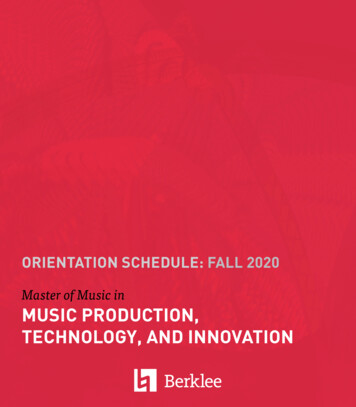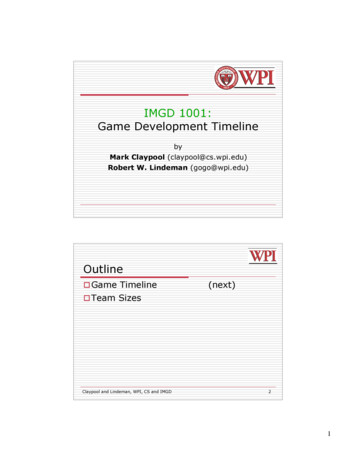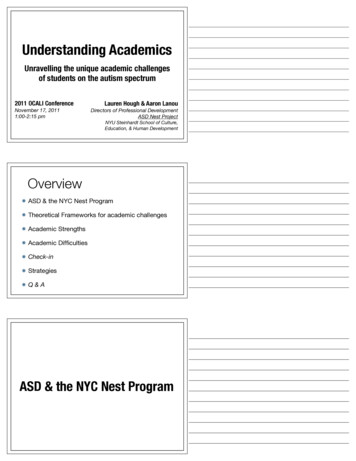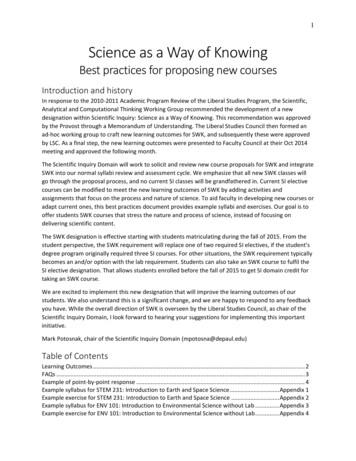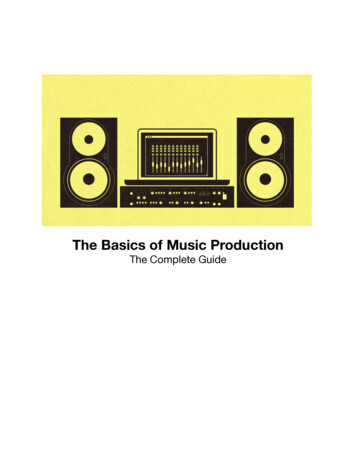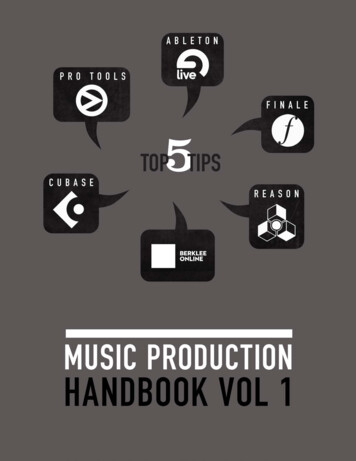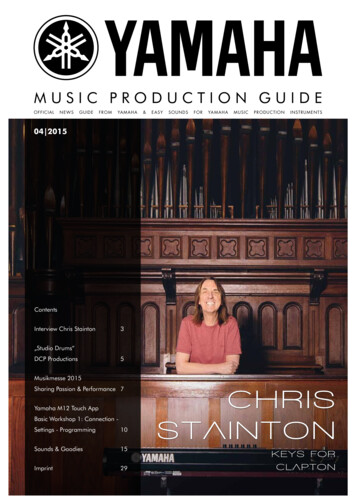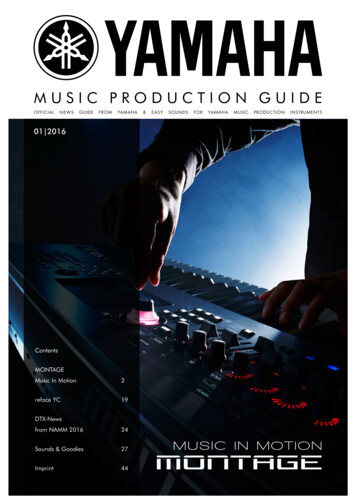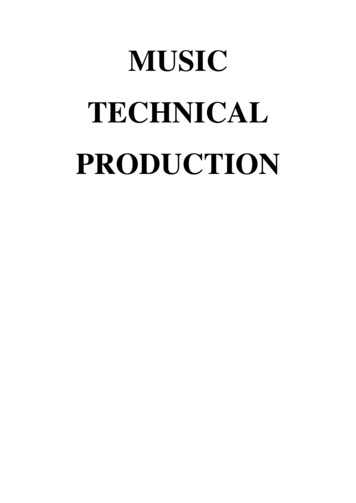
Transcription
MUSICTECHNICALPRODUCTION
INTRODUCTIONThis Course will provide the students with apractical introduction torecordingprocesses including, mixing, editing and post-production. Itwill aid the students to gain skills in recording studios and performancevenues and get on track to a career in technical production. Also it willdevelop the necessary skills to record and produce music as well as livesound operation. The course will allow the students with the opportunity toparticipate in recording sessions and follow the production processesthrough to the completion of a demo recording. Moreover , it is intended togive the students the basic skills to begin an exciting career in musicsound production or for further study and will provide them with moreskills and may improve employment opportunities.
ELECTIVEIClass-XITheoryTotal Marks: 50MUSIC AESTHETICSSECTION 11) Learning Objectivesa) BSBOHS201A Participate in OHS processes:Unit Descriptor, Elements and Performance Criteria Pre-Content, Elements and Performance Criteria, Required Skillsand Knowledge, Range Statement.b) CUFIND201A Develop and apply creative arts industryknowledge:Unit Descriptor, Elements and Performance Criteria Pre-Content, Elements and Performance Criteria, Required Skillsand Knowledge, Range Statement.c) CUSMLT201A Develop and apply musical ideas and listening skills:Unit Descriptor, Elements and Performance Criteria Pre-Content, Elements and Performance Criteria, Required Skillsand Knowledge, Range Statement.2)a)OHS and Music Industry:Introduction, Activity, Overview, Distribution, Role in music business, Songwriters and the role of the publisher, Mechanical royalties, Performingroyalties, New Technology, Music Industry-management, Music industry-thelaws, promoting a band, Stickers, Banners, Business cards, Flyers and posters,Website\ Facebook\ Myspace, Merchandise Table, Emails, Utilize the internet,Developing an image for a band, putting on a gig, Secretes to success in themusic industryb)Studio Location:Introduction, Fire safety, A historical world tour of music, Liveperformances, Introduction to musical styles, Broad categories ofmusic—art music , popular music, traditional music, music genres,
Examining the styles of the blues, Characteristics of the blue form,Practicing the style of “The Blues”, Examining the style of “Ska andReggae”, Rock steady, Reggae takes over, Reggae’s transformation, Musiccharacteristics, Etymology, History of reggae, Music characteristics, Drumsand other percussion, Bass, Guitars, Keyboards, Horns, Vocals, Lyricalthemes, Criticism of dancehall and ragga lyrics, Subgenres, Early reggae,Roots Reggae, Dub, Rockers, Lovers rock, Newer Styles and spin-offs,Dancehalls, Raggamuffin, Reggaeton, Reggae Fusion, Reggae outside theCaribbean, Practicing the style of Ska/ Reggae, Examining the stylesof the rock, Practicing the style of rock, Music Style—Metal, Heavymetal, History of Heavy Metal, Musical and Vocal Styles, Genres,Avant Grade Metal, Black Metal, Celtic Metal, Death Metal, DoomMetal, Gothic Metal, Grindcore, Hair Metal, Metalcore, New wave ofBritish heavy metal (NWOBHM), Nu-metal, Power metal, Progressive metal,Thrash metal, The future of heavy metal, Practicing the style of Metal,Recording time.3) Assignments:i. Assessment 1: a) Assignment 1: OHS Inspectionb) Assignment 2: OHS Fire and Fire Extinguishersc) Assignment 3: OHS Hearing Protectionii. Assessment 2: Worksheet 1: Styles - The Bluesiii. Assessment 3:Worksheet 2: Blues Song on Digital Recorderiv. Assessment 4: Activity Worksheet: Band Feedbackv. Assessment 5: a) Worksheet 3: Part A: Styles Ska / Reggaeb)Worksheet 3: Part B: Styles Ska / Reggaevi. Assessment 6: Worksheet 4: Styles Rockvii. Assessment 7: Worksheet 5: Styles Metalviii. Assessment 8: a) Worksheet 6: Part A: Music Industryb)Worksheet 6: Part B: History of RecordingSECTION 21) Learning Objectivesa) BSBWOR203A Work effectively with others :Unit Descriptor, Elements and Performance Criteria, RequiredSkills and Knowledge, Range Statement.
b) CUSMLT202A Apply knowledge of music culture to music making:Unit Descriptor, Elements and Performance Criteria, RequiredSkills and Knowledge, Range Statement.c)CUSMPF201A Play or sing simple musical pieces:Unit Descriptor, Elements and Performance Criteria, RequiredSkills and Knowledge, Range Statement.
2)Music Culture:Introduction, What is Music?, What is Culture? , Modern music, Examining musiccultures around the world, Examining Australia’s music culture, The future of MusicIndustry, Examining the musical instrument: Human voice, Examining the musicalinstruments: the guitar, Types of Guitars, Examining the musical instruments: thepiano, Examining musical instruments – percussion, Examining musical instruments:Synthesizers-what is a Synthesizer, How a Synthesizer creates a sound, Signalgenerating and processing components, Modulation and control components,Oscillators, Common Synthesizer waveforms, Noise: Pink/red, blue, white,Reshaping waveforms, Filters, Types of filters, Cutoff frequency, Resonance, Drive,Filter Slope, Modulation, LFO Controls,LFO envelopes, Global controls,Introduction to music notation, time signatures, scales, Music theory-Chords andsymbols, What is an ensemble.3) Assignments:i. Assessment 1: Worksheet: Music Cultureii. Assessment 2: a ) Worksheet: Digital Portable Recorders: Part Ab) Assessment 2: Worksheet: Digital Portable Recorders: Part Biii.Assessment 3: a) Direct Observation Checklist: Digital Portable Recordersb)Assessment feedback formiv. Assessment 4: Worksheet: Instruments 1v. Assessment 5:Worksheet: Instruments 2vi. Assessment 6:a) Direct Observation Checklist: Ensemble Playingb) Assessment 6: Direct Observation Checklist: Ensemble Playingviii. Assessment 7: a) Direct Observation Checklist:Studio Recordingb) Assessment Feedback form
ELECTIVEIClass XII(Course Code: 768- 769)SECTION 350Marks: Theory: 50: Practical:1) Learning Objectivesa) CUESOU07B Apply a general knowledge of audio to work activities:Unit Descriptor, Elements and Performance Criteria, RequiredSkills and Knowledge, Range Statement.b) ICAU2005B Operate computer hardware:Unit Descriptor, Elements and Performance Criteria Pre-Content, Elements and Performance Criteria, Required Skillsand Knowledge, Range Statement.2)Laboratory Lesson Plans:Introduction, Hardware/Software relationships, Introduction to DAW (DigitalAudio Workstation), Introduction to Garage Band, Features of Garage Band,Recording audio into Garage Band, Practical time for Garage Band, Introductionto Apple logic, Using MIDI and MIDI editing in LOGIC, Recording audio intoLogic, Features of Logic, Practical time for Logic, Introduction to mixing, Usingmixing tools, Introduction to EQ, Introduction to Effects, Introduction toDynamics.3) Assignments:i)Assessment 1: Test 1: Computer Hardwareii) Assessment 2: Project 1: Garage Bandiii) Assessment 3:a) Assignment: Logic Basicsb) Assessment Feedback formiii) Assessment 4: Test 2: Mix Principalsiv) Assessment 5: a) Project 2: Mixb) Project 2: Mix Marking Guide
SECTION 41) Learning Objectivesa) BSBWOR203A Work effectively with others :Unit Descriptor, Elements and Performance Criteria, RequiredSkills and Knowledge, Range Statement.b) CUSSOU201A Assist with sound recordings:Unit Descriptor, Elements and Performance Criteria, RequiredSkills and Knowledge, Range Statement.c) CUETGE15B Handle physical elements during bump inbu mp out:Unit Descriptor, Elements and Performance Criteria, RequiredSkills and Knowledge, Range Statement.2)a)Live Class Notes:Introduction : Employment in the Production Industry, Review OHS,Difference between FOH and monitor, Lifting techniques, Cable andConnectors, DI sources (keyboards acoustic GTRs, CD players), Amplifiers,Vocal Microphones: Gain before feedback and stage placement, PA Lesson.b)Studio Location:Digital recording, Types of digital recording, Introduction to the Zoom H2portable recording device, Introduction to Boss 8 track digital recorders,External microphone recording with Boss 8 track portable digital recorders,Multiple microphone recording with Boss 8 track portable digital recorders,Expanding capability of Boss Digi 8 track using external mixer and multiplemicrophones, Introduction to signal flow in analogue consoles. Differencesbetween in line and split consoles, Introduction to signal flow in audientconsole; single sound source, Multiple sound sources, Introduction to HD24,Recording from audient console Into to HD24, Multiple sound sources.c)Small PA SystemsIntroduction: home studio monitoring, live solo and duo acts, publicannouncing, Basic system equipments, Setting up equipments, Power onprocedure.d)Medium PA Systems
Medium size PA systems, Introduction:small bands, live solo and duo acts(medium sized venues), public announcing, Microphones, Mixing Console,Setting up equipment, Power on procedure, Level setting procedure,Occupational Health and Safety
3) Assignments:i. Assessment 1: Worksheet 1: Portable Digital Recorders Zoom H2ii. Assessment 2: a) OHS Observation Checklist: Safe Liftingb) Assessment Feedback Formiii. Assessment 3: Worksheet 2: Portfolio Digital Recorders Boss 8 Trackiv. Assessment 4: a) Observation Checklist: Zoom H2 and Boss 8 Trackb) Assessment Feedback formv. Assessment 5: System Setupvi. Assessment 6: Live Sound Recordingvii. Assessment 7: a) Studio Basicsb) Assessment Feedback formSUGGESTED LIST OF EQUIPMENTS-Microphones – NewmenCondensor Microphones (at least Six)Audio Console 16 track Analogue/DigitalStand (Giraffe) (6)Computer with sound card and 2 GB Ram & 500 GBHDD Capable of running AudacityXLR Cables & ConnectorsJack ConnectorsStudio speakers for Monitoring (2 L& R)COURSE COMMITTEE MEMBERS1.2.3.4.Sh. Rajiv Malik, AIR Programe Director.Sh. Rakesh Kumar, LokSabha TV.Ms.Punita Singh, Faculty, School of Convergence.Sh. K.K.Tiwari, Faculty, Amity school
recordingprocesses including, mixing, editing and post-production. It will aid the students to gain skills in recording studios and performance venues and get on track to a career in technical production. Also it will develop the necessary skills to record and produce music as well as live sound operation. The course will allow the students with the opportunity to participate in recording .
